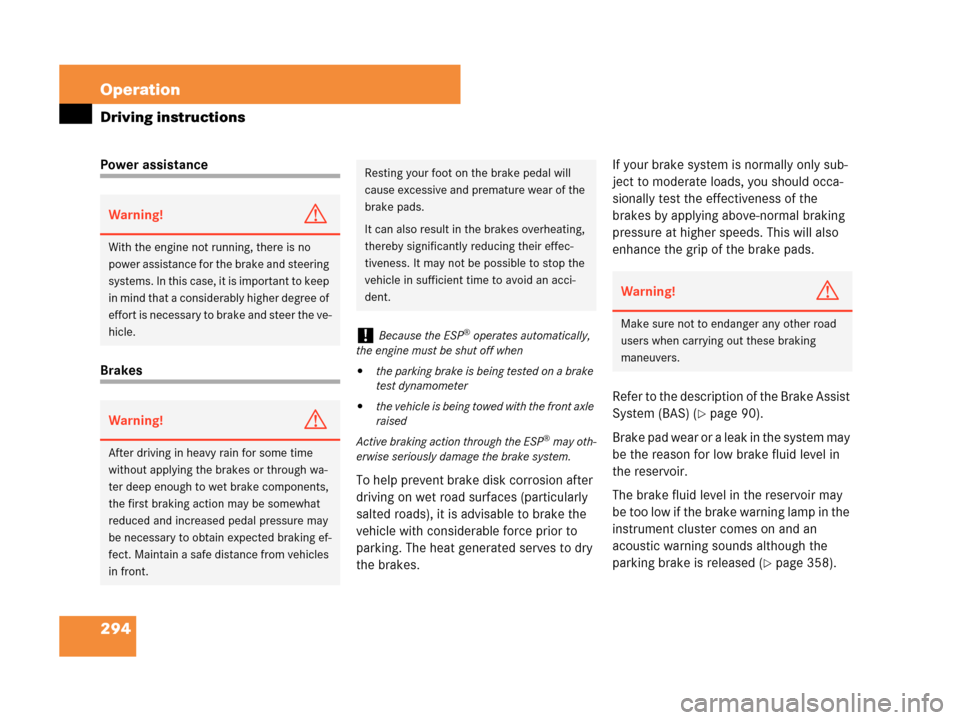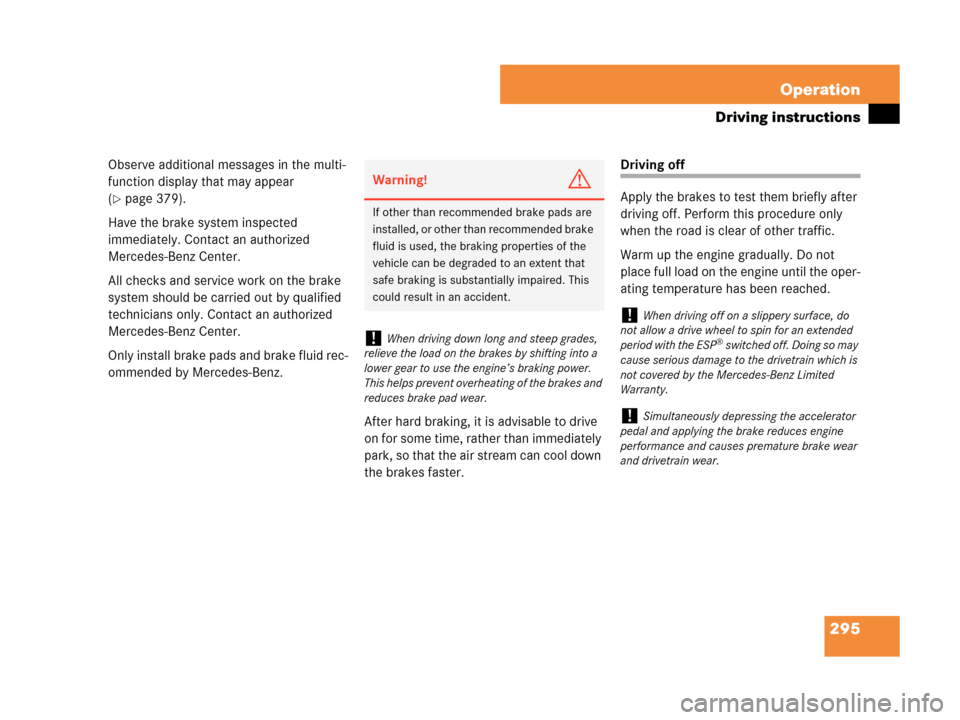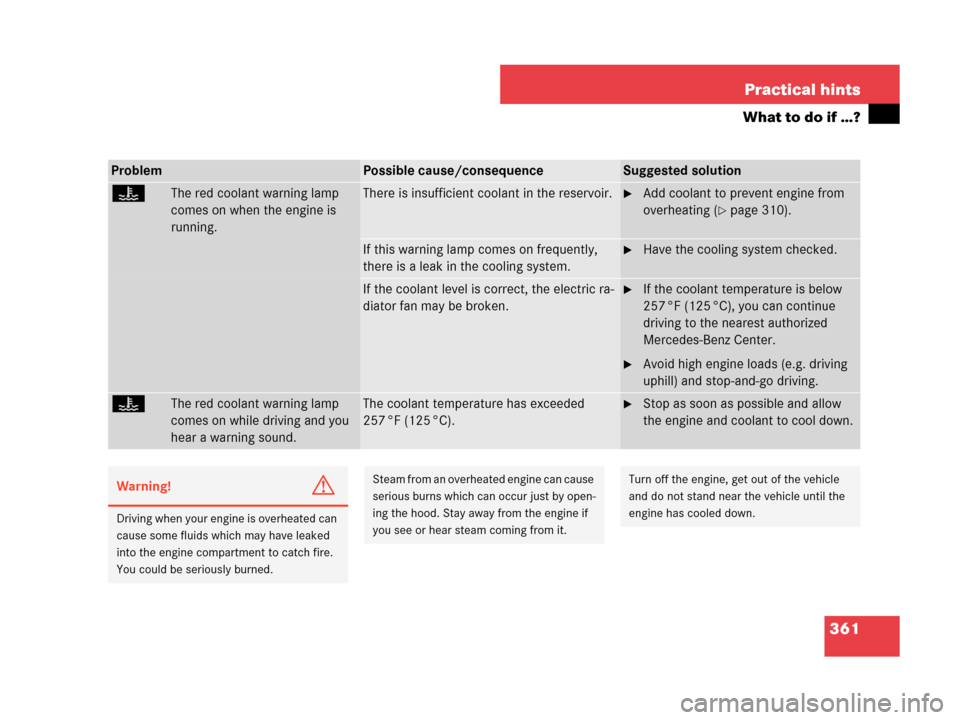Page 295 of 481

294 Operation
Driving instructions
Power assistance
Brakes
To help prevent brake disk corrosion after
driving on wet road surfaces (particularly
salted roads), it is advisable to brake the
vehicle with considerable force prior to
parking. The heat generated serves to dry
the brakes.If your brake system is normally only sub-
ject to moderate loads, you should occa-
sionally test the effectiveness of the
brakes by applying above-normal braking
pressure at higher speeds. This will also
enhance the grip of the brake pads.
Refer to the description of the Brake Assist
System (BAS) (
�page 90).
Brake pad wear or a leak in the system may
be the reason for low brake fluid level in
the reservoir.
The brake fluid level in the reservoir may
be too low if the brake warning lamp in the
instrument cluster comes on and an
acoustic warning sounds although the
parking brake is released (
�page 358).
Warning!G
With the engine not running, there is no
power assistance for the brake and steering
systems. In this case, it is important to keep
in mind that a considerably higher degree of
effort is necessary to brake and steer the ve-
hicle.
Warning!G
After driving in heavy rain for some time
without applying the brakes or through wa-
ter deep enough to wet brake components,
the first braking action may be somewhat
reduced and increased pedal pressure may
be necessary to obtain expected braking ef-
fect. Maintain a safe distance from vehicles
in front.
Resting your foot on the brake pedal will
cause excessive and premature wear of the
brake pads.
It can also result in the brakes overheating,
thereby significantly reducing their effec-
tiveness. It may not be possible to stop the
vehicle in sufficient time to avoid an acci-
dent.
!Because the ESP® operates automatically,
the engine must be shut off when
�the parking brake is being tested on a brake
test dynamometer
�the vehicle is being towed with the front axle
raised
Active braking action through the ESP
® may oth-
erwise seriously damage the brake system.
Warning!G
Make sure not to endanger any other road
users when carrying out these braking
maneuvers.
Page 296 of 481

295 Operation
Driving instructions
Observe additional messages in the multi-
function display that may appear
(
�page 379).
Have the brake system inspected
immediately. Contact an authorized
Mercedes-Benz Center.
All checks and service work on the brake
system should be carried out by qualified
technicians only. Contact an authorized
Mercedes-Benz Center.
Only install brake pads and brake fluid rec-
ommended by Mercedes-Benz.
After hard braking, it is advisable to drive
on for some time, rather than immediately
park, so that the air stream can cool down
the brakes faster.
Driving off
Apply the brakes to test them briefly after
driving off. Perform this procedure only
when the road is clear of other traffic.
Warm up the engine gradually. Do not
place full load on the engine until the oper-
ating temperature has been reached.
Warning!G
If other than recommended brake pads are
installed, or other than recommended brake
fluid is used, the braking properties of the
vehicle can be degraded to an extent that
safe braking is substantially impaired. This
could result in an accident.
!When driving down long and steep grades,
relieve the load on the brakes by shifting into a
lower gear to use the engine’s braking power.
This helps prevent overheating of the brakes and
reduces brake pad wear.
!When driving off on a slippery surface, do
not allow a drive wheel to spin for an extended
period with the ESP
® switched off. Doing so may
cause serious damage to the drivetrain which is
not covered by the Mercedes-Benz Limited
Warranty.
!Simultaneously depressing the accelerator
pedal and applying the brake reduces engine
performance and causes premature brake wear
and drivetrain wear.
Page 362 of 481

361 Practical hints
What to do if …?
ProblemPossible cause/consequenceSuggested solution
•The red coolant warning lamp
comes on when the engine is
running.There is insufficient coolant in the reservoir.�Add coolant to prevent engine from
overheating (
�page 310).
If this warning lamp comes on frequently,
there is a leak in the cooling system.�Have the cooling system checked.
If the coolant level is correct, the electric ra-
diator fan may be broken.�If the coolant temperature is below
257 °F (125 °C), you can continue
driving to the nearest authorized
Mercedes-Benz Center.
�Avoid high engine loads (e.g. driving
uphill) and stop-and-go driving.
•The red coolant warning lamp
comes on while driving and you
hear a warning sound.The coolant temperature has exceeded
257 °F (125 °C).�Stop as soon as possible and allow
the engine and coolant to cool down.
Warning!G
Driving when your engine is overheated can
cause some fluids which may have leaked
into the engine compartment to catch fire.
You could be seriously burned.
Steam from an overheated engine can cause
serious burns which can occur just by open-
ing the hood. Stay away from the engine if
you see or hear steam coming from it.Turn off the engine, get out of the vehicle
and do not stand near the vehicle until the
engine has cooled down.